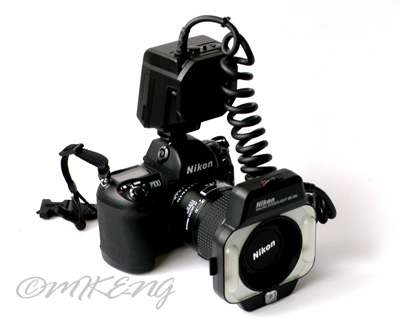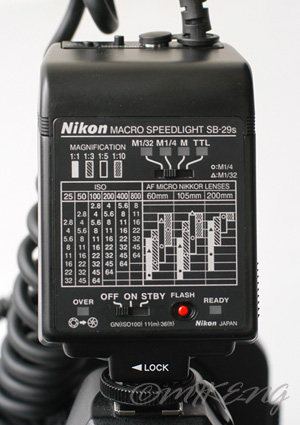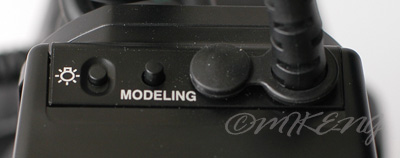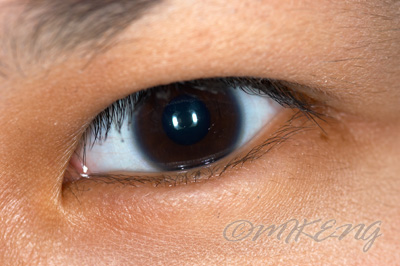





 |
 |
 |
 |
 |
 |
| Michael Ng | profile | all galleries >> Photo Gear & Reviews >> Nikon SB-29s | tree view | thumbnails | slideshow |
 The SB-29s mounted on a Nikon F100 body and 105mm f/2.8D AF macro lens. |
Introduction: The Nikon SB-29s was the successor of the SB-29, which in turn was the successor of the SB-21. Though this flash unit could be considered a luxury item for casual photographers, it is a godsend for those who are passionate about macrophotography; especially those who work with limited camera-to-subject distances. As of November 2005, the SB-29s has been discontinued and been replaced by the R1 Wireless Close-Up Speedlight System which features i-TTL. My previous experience with the SB-29, which was the predecessor to the SB-29s wasn’t as pleasant as I’d liked. I didn’t like how I had to look at the charts at the back of the unit to predict how my shots would turn out. I also didn’t like how I couldn’t tell how what I was doing affected my images until I collected my prints from the store. And when I did find out, I wasn’t at all pleased. So within about two weeks I sold it off. When the SB-29s was launched in 2002, which was about the time I got my D100 I started getting interested once again in a ring flash. The SB-29s was introduced to allow D-SLR users the benefit of using the SB-29. The original SB-29 was too powerful for CCD sensors even with the lens stopped down at the minimum aperture, resulting in washed out images. The new SB-29s has an extra M 1/32 flash output setting which is much less than the minimum output of M ¼ that the SB-29s has. So the problem was solved. But still only Manual mode can be used. TTL is available only for the F5, F100, F80, F65 and FM3A (Nikon Press Release). Everything else about the SB-29s is exactly the same as its older brother. | |
 The SB-29s unit. |
In the Box: The SB-29s unit comes packed neatly in a SS-29 PVC carrying case. Also included are the adaptor rings that enable you to attach the flash unit to the end of your lens. The adaptors come as screw-in filters of sizes 52mm, 62mm and 72mm. If your lens doesn’t have either one of those filter thread sizes, then the need of a step-up or a step-down ring may arise. I’m just a little disappointed that the maximum diameter isn’t the professional standard 77mm. Features: The SB-29s can be divided into two parts. One is the flash unit, where the tubes are housed, and two is the control unit where the main functions and batteries are located. Both parts are connected to each other by a thick slinky-like rubber cable. Both units can be connected to each other by clipping the flash unit onto the front of the control unit. That’s to ensure that the unit stays in one piece rather than two separate clumsy parts for easy storage. This arrangement also turns the SB-29s into a regular speedlight. |
|
 The back panel of the control unit.  The top of the control unit with the AF assist and modelling buttons. |
The Control Unit: The control unit sits on the camera’s hot-shoe. It is where all the controls are. There’s a switch to toggle between TTL and the Manual outputs (M=1:1, M1/4= 1:4, M1/32= 1:32). There are also the ON:OFF:STANDBY switches and a test firing button. The SB-29s also has a nice warning light indicating overexposure. Printed on the back is a table that helps you get the correct exposure. I find this feature pretty difficult to use because of the number of variables that you have to take into account. Apart from the ISO number you have to note the aperture, magnification ratio you’re using and the lens that you have on. Another gripe that I have is that there’s data only for the three existing AF Micro Nikkors. If a new one comes out, then you’re pretty screwed if you’re shooting film. On digital, all this mess is cleared up via your LCD preview or even better, your histogram. On the top of the control unit, there are some very useful functions, which are the modeling light and the AF assist buttons. The modeling light when pressed causes the SB-29s to fire a series of rapid flashes which you can preview through your viewfinder. This way you can kind of predict where the shadows in your image will be. I would not trust it for predicting exposure. I would like to see the modeling light somehow linked with the DOF preview button on SLRS, where when the DOF preview button is activated, the modeling light too is triggered. The AF assist button works just like the AF assist illuminators found on speedlights and Nikon bodies with built-in flash units, with a slight difference. Unlike the conventional AF assist lamps, this one stays on with a press of a button and is deactivated when the button is pressed again. I don’t think it should be called AF assist illuminator, but rather just a Focus Assist illuminator, because I found this feature indispensable for low-light manual focusing too. The top of the control unit also hosts a TTL flash terminal, which allows you to use your SB-29s with other flash units via a PC sync cord. This is especially useful if you have flash units without wireless capability. |
|
 Top of flash unit has switches to control the module outputs individually. |
The Flash Unit: The SB-29s really isn’t a true ring flash with flash bulbs arranged in a circle or a continuous circular flash tube. It is actually two flash modules opposite each other encased in a circular housing. Having the output arranged that way actually has its benefits. The main plus is that the output of each module can be adjusted independently of each other. Why would someone want to vary the output of the individual modules? Ring flashes are notorious for producing flat and shadow-less images. Some argue that the sun is a single light source, so why should you have two? By adjusting the modules’ outputs individually, some soft shadows can be produced for a more natural and 3-D like effect for subjects. Varying the output can be done by two methods: One of the ways is to adjust the switch silk-screened in white. It is a three way switch which toggles between “left only” to “both modules” to “right only”. (See pic). In other words, you can fire the modules individually or you can fire them simultaneously. Firing just one of the modules can produce rather harsh directed lighting in some applications. Thus there’s a second option for the user to vary the SB-29’s output, which is operated via the green and orange labeled switch called the built-in light reducer switch. This switch is actually a slider which slides a diffuser over each module independently. This diffuser reduces the flash tube that it covers by 1/4. As a result, one side has a stronger output than the other but the shadows produced aren’t as dark. |
|
 Characteristic of ringlights, catchlights in the eyes of subjects resemble rings. Due to the small aperture used, only parts with higher intensity (the modules) show.  To avoid a flat-looking image, the output of the right module was reduced. |
In the field: Though many may see this flash as only a macro ring light, with a little creativity, the SB-29s can be a very versatile source of lighting. One of the benefits of having the controller and the flash modules as separate units is the ability to change the direction of your light source. The SB-29s allows you to shoot in one of three ways: i)As a standard ringflash, mounted on your lens filter thread. ii)As a regular flash unit, mounted on the controller, on your camera hotshoe. iii)As an external flash unit as if connected via a SC-17 cord. Transporting the unit about can be a little cumbersome. Attached to the controller unit (storage position), the SB-29s is very odd-shaped. Having a rather long and springy cable dangling around too can be difficult. Conclusions: The SB-29s is a great accessory for those with a limited shooting distance (eg. with macro bellows) and want to get some frontal illumination for their subjects. However limiting the SB-29s only for macro use is really like driving a Viper at 40mph. There’s definitely more potential. Using the ringflash on a D-SLR takes out the guesswork on exposure. Now users can get instant feedback, which is a revelation in contrast to the days of shooting only with film. Unfortunately, no TTL, so users are advised to be familiar with their cameras’ aperture, shutter and ISO buttons. Even if you’re not in the field of dentistry or forensic science, the SB-29s will make a great addition to your rig if you’re really into macrophotography. Shooting with the SB-29s is a whole lot easier than shooting with two flash units mounted on a flash bracket or fiddling with reflectors to get more light when shooting bugs. But at a price range similar to the SB-800, this flash may not be something for everyone. ©Michael Ng 2005 |
| comment | share |
| Tek sovathero | 19-Jan-2012 08:03 | |
| John | 05-Jun-2009 18:10 | |
| K. Manner | 20-Feb-2009 17:14 | |
| K. Manner | 20-Feb-2009 16:52 | |
| A guest from Hong Kong | 21-Nov-2008 03:23 | |
| Guest | 06-Mar-2008 16:45 | |
| Stewart | 08-Feb-2008 11:27 | |
| Jose A. Morales | 03-Oct-2007 03:59 | |
| Michael Ng | 24-Feb-2007 10:29 | |
| Chris | 24-Feb-2007 05:07 | |
| Michael Ng | 10-Dec-2005 01:15 | |
| Chrystal (1e's sis) | 09-Dec-2005 23:30 | |